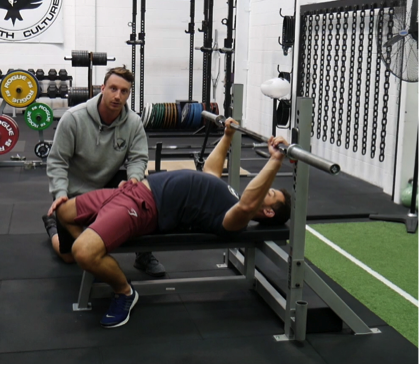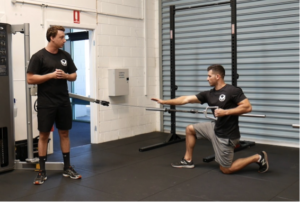
The Issue With Most Powerlifting-Specific Programs
Today’s guest post comes from former Cressey Sports Performance intern, Jamie Smith.
All athletes are humans that express biomotor qualities in their sport of choice. Think strength, power, speed, agility, endurance, balance and flexibility. Their ability to express these biomotor qualities – combined with their actual task-specific skills – is what makes them the athletes they are. However, before people are athletes, they are humans: humans expressing these physical qualities; humans that require strength, conditioning, and movement variability to consistently and successfully perform their sport. When a human hires a strength and conditioning coach, it is assumed that the strength coach will oversee the human’s program, guide the human, and keep the human safe throughout their “career” as they progress and get better at expressing their physical qualities in their sport of choice.
For example, when a young baseball player hires a baseball specific strength and conditioning coach, the devised program will encompass aspects of core stabilization drills to strengthen the core for the sport’s rotational demands. The program has lower and upper body strength work to increase the potential power output for throwing and hitting. There are PREhabilitaiton exercises (such as rotator cuff strengthening drills) to support throwing loads. The program reflects the demands of the sport and includes exercises to prevent “baseball specific injuries.”
Powerlifting appears to be in a grey area of strength and conditioning, though. Powerlifting is a very specific sport that really only requires one biomotor quality: strength. Secondary to this, the sport is completed entirely inside the gym, so a lot of powerlifting coaches only look at the gym as the sport itself, strength training, rather than seeing the gym as a potential avenue to prevent “powerlifting specific injuries.” On the other hand, a strength coach from any other sport will look at the gym as a place for the athlete to improve their athletes’ physical qualities AND prevent injuries.
This is where a majority of powerlifting programs miss the mark in terms of “sports performance.” If you have followed Eric Cressey’s blog for any number of years, you would have read a vast number of articles referencing the issues that arise for athletes when their training and sport is purely “extension based.” From head-to-toe, the list of body dysfunctions that arise from training and “sports performance” that drive purely extension based movements is almost endless.
When we break down the powerlifting programs more generally that place sole focus on the big three and their variations, we begin to see how this extension focused training becomes an issue.
The squat drives extension through the thoracic spine and – for those who don’t understand correct bracing strategies – quite often the lumbar spine, too. Lat tension is achieved by pulling on the bar, helping create trunk stability. And, activation of every extension based muscle is needed to stand up with the weight every single rep.
The bench press requires global spinal extension in order to create an arch, reduce range of motion and stabilize the scapula. Lat activation is necessary to support and stabilize the thoracic spine and scapula further. Retraction and depression of the scapula aids in glenohumeral stability.
The deadlift, obviously, demands extension of the entire system with significant loads.
Powerlifting is an extension-based sport, and when you couple it with the extreme loads that the body is under, a lot of the same extension-based issues from other sports begin to arise.
So what can be done to improve powerlifting programs in order to reduce the risk of injury? Try these six strategies.
1. Restore some flexion back into the system.
For us at Melbourne Strength Culture, the PRI Breathing Drill – 90/90 Hip Lift – is our first port of call. This allows the body to regain some much needed flexion through the hips and thoracic spine. This also couples as a great teaching and motor control drill to improve intra-abdominal pressure. Do this DAILY!
2. Increase anterior core strength and endurance.
Planks, dead bugs, ab wheel roll-outs and all their variations are a great place to start. Do these DAILY!
3. Incorporating ‘reaching’ drills in your warm ups.
Back to wall shoulder flexion, forearm wall slides, foam roller wall slides. Get some much need protraction, upward rotation, thoracic flexion, serratus anterior and lower trap activation to improve your scapular stability. Do these DAILY!
4. Utilize loaded reaching exercises.
Incorporate loaded push-ups, landmine press variations, and overhead pressing variations – both unilateral and bilateral – to get the scapula moving.
5. Drive some thoracic rotation by incorporating unilateral rowing exercises.
Half-kneeling 1-arm cable rows with reaches are tremendously effective. The spine, the rib cage and scapula function better synergistically when movement variability is included in a program. Restore some flexion and rotation capacity in the thoracic spine and allow the scapula to have a convex interface to support it.
A strength and conditioning program should highlight and strengthen the biomotor skills needed to excel in the sport AND prevent the injuries that arise from overexposure to the stressors of a given sport, so why is powerlifting any different?
About the Author
Jamie Smith is owner and head coach at Melbourne Strength Culture. You can find Jamie on Instagram and YouTube.





